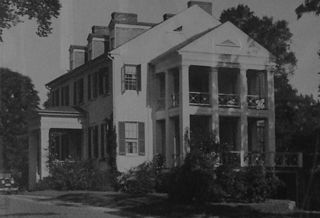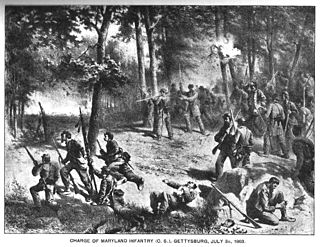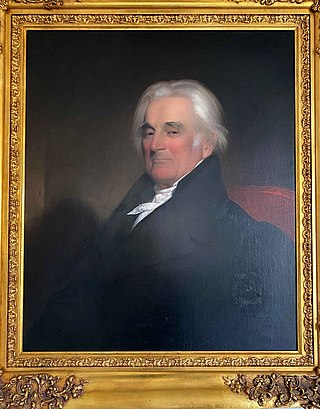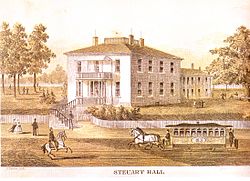
Spring Grove Hospital Center, formerly known as Spring Grove State Hospital, is a psychiatric hospital located in the Baltimore, Maryland, suburb of Catonsville.

George Hume Steuart was a planter in Maryland and an American military officer; he served thirteen years in the United States Army before resigning his commission at the start of the American Civil War. He joined the Confederacy and rose to the rank of brigadier general in the Army of Northern Virginia. Nicknamed "Maryland" to avoid verbal confusion with Virginia cavalryman J.E.B. Stuart, Steuart unsuccessfully promoted the secession of Maryland before and during the conflict. He began the war as a captain of the 1st Maryland Infantry, CSA, and was promoted to colonel after the First Battle of Manassas.

During the American Civil War (1861–1865), Maryland, a slave state, was one of the border states, straddling the South and North. Despite some popular support for the cause of the Confederate States of America, Maryland did not secede during the Civil War. Governor Thomas H. Hicks, despite his early sympathies for the South, helped prevent the state from seceding.

The Maryland Army National Guard is the United States Army component of the U.S. state of Maryland. It is headquartered at the old Fifth Regiment Armory at the intersection of North Howard Street, 29th Division Street, near Martin Luther King, Jr. Boulevard in Baltimore and has additional units assigned and quartered at several regional armories, bases/camps and other facilities across the state.
George Hume Steuart, (1700–1784) was a Scottish physician, tobacco planter, and Loyalist politician in colonial Maryland. Born in Perthshire, Steuart emigrated to Maryland in around 1721, where he benefited from proprietarial patronage and was appointed to a number of colonial offices, eventually becoming a wealthy landowner with estates in both Maryland and Scotland, and serving two terms as mayor of Annapolis. However, he was forced by the outbreak of the American Revolution to decide whether to remain loyal to the Crown or to throw in his lot with the American rebels. In 1775 Steuart sailed to Scotland, deciding at age 75 that "he could not turn rebel in his old age". He remained there until his death in 1784.

Dodon, is a 550-acre (2.2 km2) farm and former forced-labor tobacco plantation near Davidsonville, Maryland, located near the South River about 10 miles (16 km) south west of Annapolis. Purchased in 1747 by the planter and politician Dr George H. Steuart, it remains the home of Steuart's descendants to this day. Steuart grew wealthy during the colonial era thanks to proprietorial patronage and the forced labor of enslaved people.

Richard Sprigg Steuart (1797–1876) was a Maryland physician and an early pioneer of the treatment of mental illness. In 1838 he inherited four contiguous farms, totalling approximately 1900 acres as well as 150 slaves.

George Hume Steuart (1790–1867) was a United States general who fought during the War of 1812, and later joined the Confederate States of America during the Civil War. His military career began in 1814 when, as a captain, he raised a company of Maryland volunteers, leading them at both the Battle of Bladensberg and the Battle of North Point, where he was wounded. After the war he rose to become major general and commander-in-chief of the First Light Division, Maryland Militia.
Dungannon,, was a thoroughbred racehorse owned by the tobacco planter and horse breeder George Hume Steuart (1700–1784), who imported the horse from England to race against his rival, Charles Carroll of Annapolis (1703–1783). Dungannon won the Annapolis Subscription Plate, in May 1743, the first recorded formal horse race in colonial Maryland, and the second oldest in North America.

Benedict Swingate Calvert was a planter, politician and a Loyalist in Maryland during the American Revolution. He was the son of Charles Calvert, 5th Baron Baltimore, the third Proprietor Governor of Maryland (1699–1751). His mother's identity is not known, though one source speculates that she was Melusina von der Schulenburg, Countess of Walsingham. As he was illegitimate, he was not able to inherit his father's title or estates, which passed instead to his half brother Frederick Calvert, 6th Baron Baltimore (1731–1771). Benedict Calvert spent most of his life as a politician, judge and planter in Maryland, though Frederick, by contrast, never visited the colony. Calvert became wealthy through proprietarial patronage and became an important colonial official, but he would lose his offices and his political power, though not his land and wealth, during the American Revolution.

Jarvis U.S. General Hospital was a military hospital founded in Baltimore, Maryland, in 1861, at the beginning of the American Civil War, for the care of wounded Federal soldiers. The hospital was built on the grounds of Maryland Square, the former residence of the Steuart family, which had been confiscated by the Federal government at the outbreak of war. The hospital closed at the end of the war.

The Washington Blues were a company of Maryland Volunteers which saw action during the Battle of Bladensburg and the Battle of North Point, during the War of 1812.

The Maryland Line in the Army of the Confederate States of America was made up of volunteers from Maryland who, despite their home state remaining in the Union, fought for the Confederate States of America during the American Civil War. Of approximately 25,000 Marylanders who volunteered, most fought in the Army of Northern Virginia, and it was not until late in 1863 that a Maryland Line in the CSA was formally created. However, by this late stage in the war, few men wished to leave the units they had fought alongside for more than two years, and the exiles' dream of an independent Maryland Line in the Confederate army would never be fully realized.

The Steuart family of Maryland was a prominent political family in the early history of Maryland. The Steuarts, of Scottish descent, have their origins in Perthshire, Scotland. The family grew wealthy in the early 18th century under the patronage of the Calvert family, proprietors of the colony of Maryland, but their wealth and status was much reduced during the American Revolution, and the American Civil War.
Grace Medical Center, formerly known as Bon Secours Hospital, is a hospital in Baltimore. The hospital is part of LifeBridge Health, a nonprofit healthcare corporation that was formed in 1998 and currently operates several medical institutions in and around Baltimore, Maryland.
Like other border states, Maryland found herself in a difficult position at the start of the American Civil War, with loyalties divided between North and South. Although Maryland herself remained in the Union, Maryland militia units fought on both sides of the Civil War. Many militia members travelled south at the start of the war, crossing the Potomac River to join the Confederate Army of Northern Virginia.

William Steuart was a stone mason in colonial Maryland, and Mayor of Baltimore from 1831 to 1832. He was a lieutenant colonel in the United States Army during the War of 1812, and saw service during the Battle of Baltimore, where he commanded the 38th United States Infantry foot regiment.

The First Light Division of Maryland Volunteers was a militia unit based in Baltimore and formed in around 1841. Its commander was the militia general George H. Steuart. Elements of the division participated in the suppression of John Brown's raid on Harper's Ferry in 1859, but its members found themselves in a difficult position at the outbreak of the American Civil War in 1861. Many of the citizen volunteers, especially the senior command, wished to secede from the Union and join the Confederate States of America. However, Maryland remained loyal to the Union during the Civil War and as a consequence of this the division was disbanded. Many of its members left Maryland and went south to fight for the Confederacy.

William Frederick Steuart (1816–1889) was a Maryland-born medical doctor who served in the Confederate States Army during the American Civil War. He was a surgeon in the 3rd North Carolina Infantry Regiment, a unit that formed part of the brigade commanded by his cousin, General George H. Steuart. After the war he returned to Maryland and served as resident physician at the Maryland Hospital for the Insane, an institution founded largely thanks to the efforts of another cousin, Richard Sprigg Steuart.

William Steuart was a wealthy planter in colonial Maryland. He inherited the estate of Dodon in Anne Arundel County, Maryland, from his father, planter and politician George H. Steuart.




















